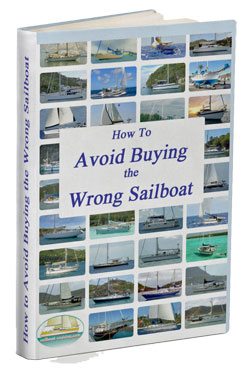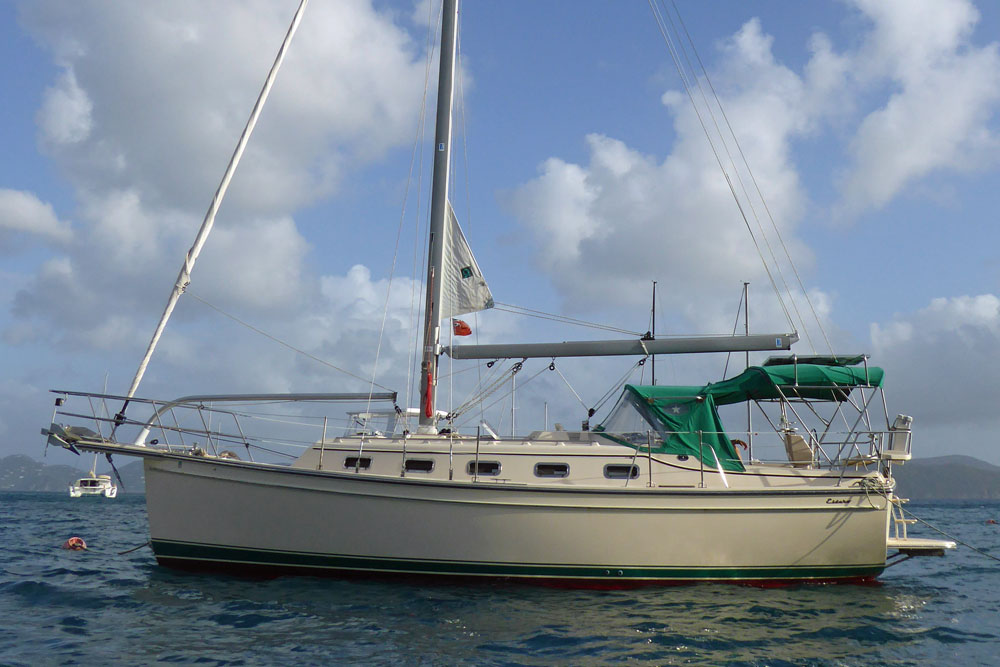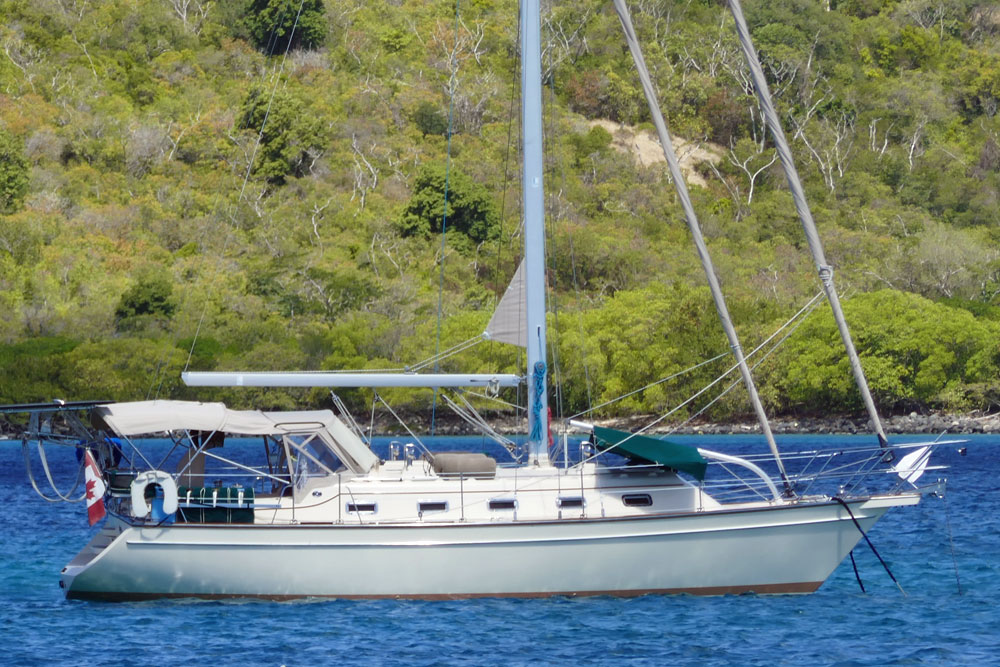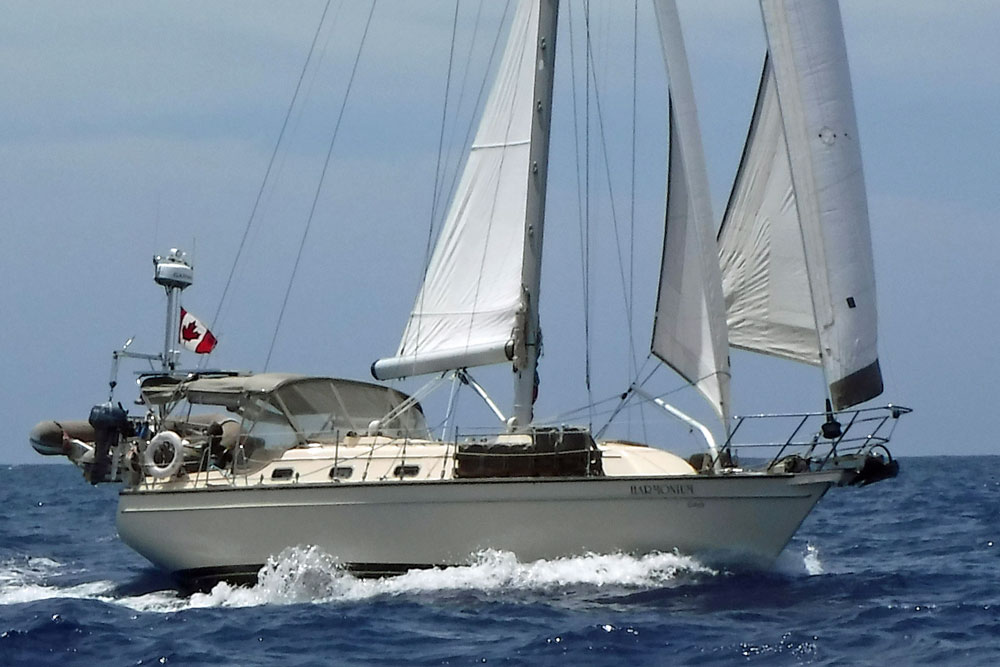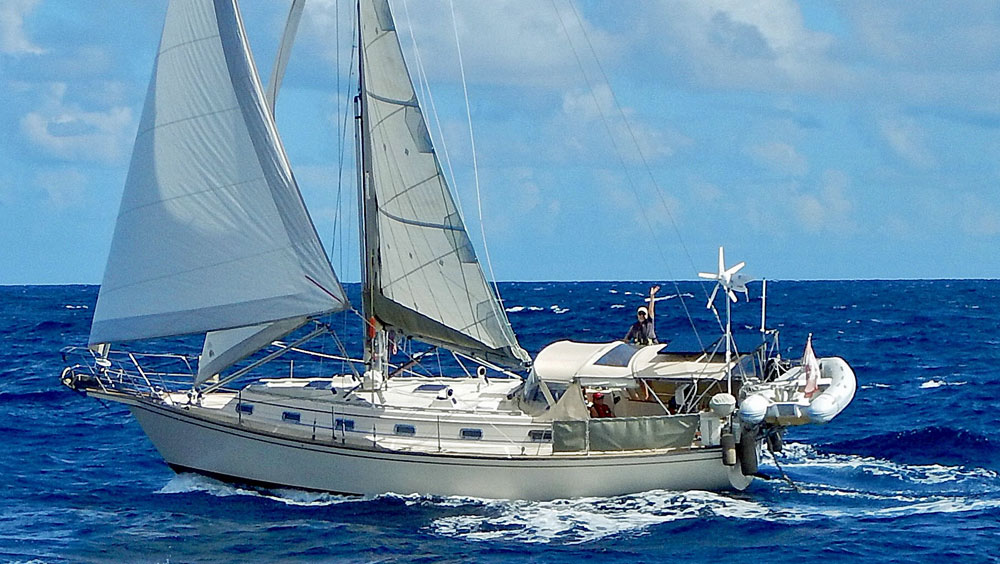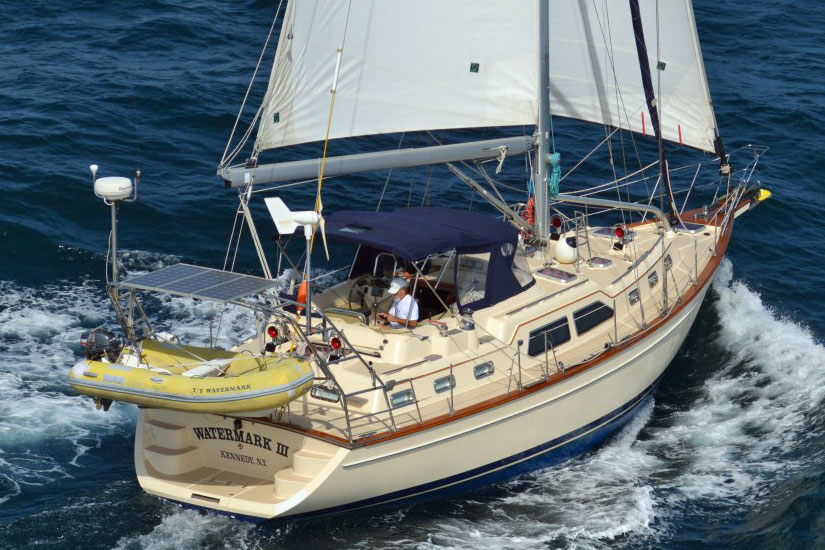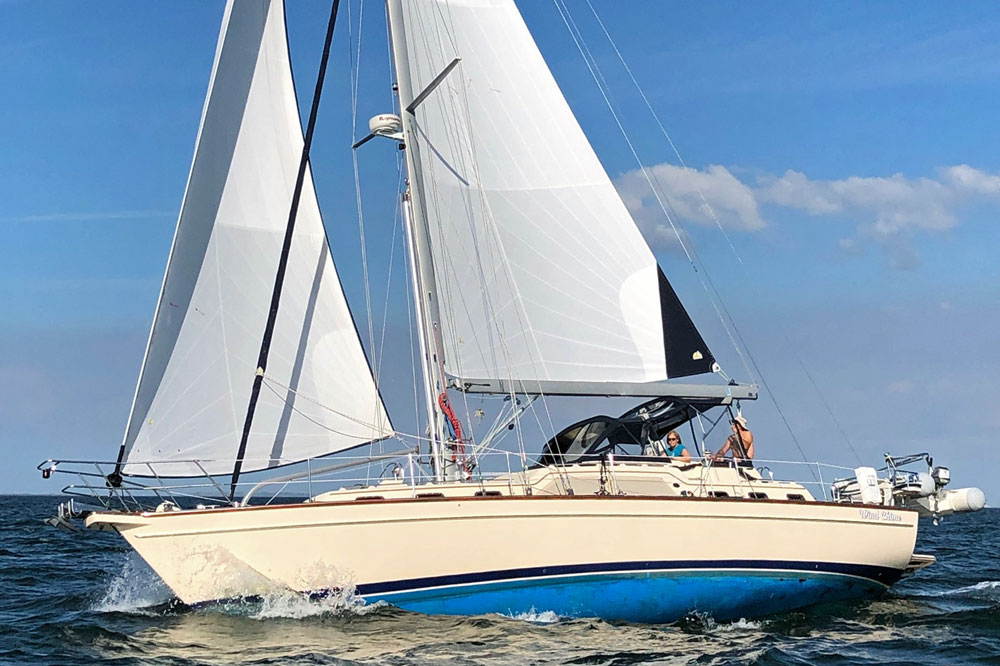- Home
- Cruising Yachts 35' to 40'
- Island Packet 38
The Island Packet 38 Sailboat
Specs & Key Performance Indicators
The Island Packet 38, a long-keeled aft-cockpit cutter, was designed by Bob Johnson and built in the USA by Island Packet Yachts.
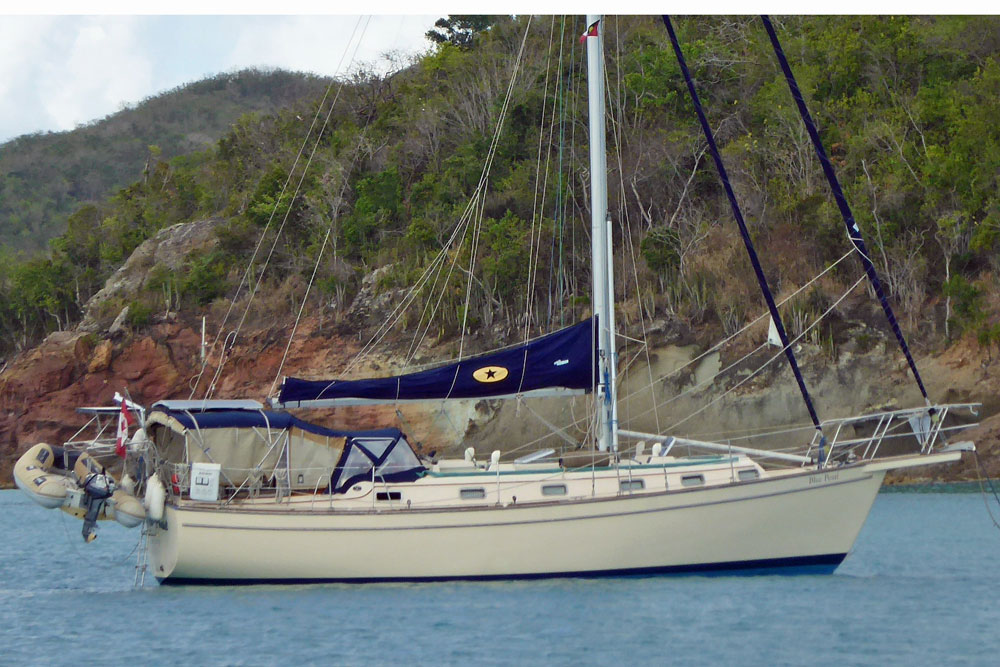 An Island Packet 38 cutter. Note the club-footed furling staysail and the four dorade vents providing good ventilation below.
An Island Packet 38 cutter. Note the club-footed furling staysail and the four dorade vents providing good ventilation below.Published Specification for the Island Packet 38
Hull Type: Long keel
Hull Material: GRP (Fiberglass)
Length Overall: 38'0" (11.6m)
Waterline Length: 33'0" (10.1m)
Beam: 12'8" (3.9m)
Draft: 5'0" (1.5m)*
Rig Type: Cutter
Displacement: 21,500lb (9,752kg)
Designer: Bob Johnson
Builder: Island Packet Yachts (USA)
Year First Built: 1986
Year Last Built: 1993
Number Built: 188
Owners Association: Island Packet Yacht Owners Association
* A centreboard version was also offered with a board-down draught of 7'7" and 4'0" with it up.
Published Design Ratios for the Island Packet 38
Sail Area/Displacement Ratio: 18.1
Ballast/Displacement Ratio: 46.5
Displacement/Length Ratio: 267
Comfort Ratio: 32.7
Capsize Screening Formula: 1.8
Summary Analysis of the Design Ratios for the Island Packet 38
1. A Sail Area/Displacement Ratio of 18.1 suggests that the Island Packet 38 will, in the right conditions, approach her maximum hull speed readily and satisfy the sailing performance expectations of most cruising sailors.
2. A Ballast/Displacement Ratio of 46.5 means that the Island Packet 38 will stand up well to her canvas in a blow, helping her to power through the waves.
3. A Displacement/Length Ratio of 267, tells us the Island Packet 38 is a moderate displacement cruiser, which means she'll carry all your cruising gear without it having a dramatic effect on her performance. Most of today's sailboats intended for offshore cruising fall into this displacement category.
4. Ted Brewer's Comfort Ratio of 32.7 suggests that crew comfort of an Island Packet 38 in a seaway is similar to what you would associate with the motion of a moderate bluewater cruising boat - a predictable and acceptable motion for most seasoned sailors.
5. The Capsize Screening Formula (CSF) of 1.8 tells us that an Island Packet 38 would be a safer choice of sailboat for an ocean passage than one with a CSF of more than 2.0.
More about the Island Packet 38...
The Island Packet 38 is a classic bluewater cruiser that combines comfort, performance, and seaworthiness in a spacious and well-appointed package. The Island Packet 38 features a cutter rig, a long keel, a skeg-hung rudder, and a spacious cockpit. It has a reputation for being solid, sturdy, and reliable, as well as being easy to handle and maintain.
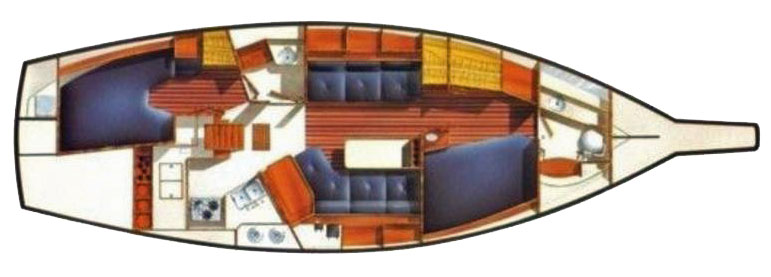 The accommodation plan provides for a spacious Pullman berth forward of the main salon along with another double berth below the cockpit
The accommodation plan provides for a spacious Pullman berth forward of the main salon along with another double berth below the cockpitAccommodation
The Island Packet 38 can accommodate up to seven people in three separate cabins.
- The forward cabin has a large 'Pullman' berth with ample storage and an ensuite head with shower;
- The main saloon has a U-shaped dinette that converts to a double berth, a settee that converts to a single berth, and a fold-down table;
- The navigation station is located to starboard, forward of the galley;
- The galley has a three-burner stove with oven, a double sink, a refrigerator/freezer, and plenty of counter space and storage;
- The aft cabin has a large double berth, a hanging locker, and access to the second head with shower.
Hull and Deck
The hull of the Island Packet 38 is made of fiberglass with a vinylester resin barrier coat to prevent osmosis. The deck is also made of fiberglass with a core of end-grain balsa wood for stiffness and insulation. The deck has a molded-in nonskid surface for safety and durability. The deck features wide side decks, high bulwarks, sturdy handrails, and numerous opening ports and hatches for ventilation and light. The cockpit is large and comfortable, with high coamings, long seats, and a folding table. The boat is steered by a single wheel mounted on a pedestal with instruments and engine controls.
Mast and Rigging
The mast of the Island Packet 38 is made of anodized aluminum and is keel-stepped for strength and stability. The mast has two sets of spreaders and supports a cutter rig with a mainsail, a staysail, and a genoa. The mast has in-mast furling for the mainsail and roller furling for the headsails for convenience and ease of handling. The rigging is made of stainless steel wire with swaged terminals and turnbuckles. The rigging includes an inner forestay for the staysail, an outer forestay for the genoa, upper and lower shrouds, intermediate shrouds, backstay, running backstays, boom vang, topping lift, outhaul, reefing lines, halyards, sheets, and traveler.
Keel and Rudder
The keel of the Island Packet 38 is a long keel that runs the length of the hull. It is made of lead encapsulated in fiberglass and provides stability, directional control, and protection for the propeller and rudder. The keel has a draft of 5 feet (1.5 meters) and a ballast of 10,000 pounds (4,536 kilograms).
The rudder of the Island Packet 38 is skeg-hung, meaning that it is attached to a fin that extends from the keel. This design provides strength, support, and protection for the rudder. The rudder is made of fiberglass with a stainless steel stock and has a balanced shape for easy steering.
This article was written with the assistance of Gemini, a large language model developed by Google. Gemini was used to gather information, summarize research findings, and provide suggestions for the content and structure of the article.
Other sailboats in the Island Packet range include:
Recent Articles
-
Albin Ballad Sailboat: Specs, Design, & Sailing Characteristics
Jul 09, 25 05:03 PM
Explore the Albin Ballad 30: detailed specs, design, sailing characteristics, and why this Swedish classic is a popular cruiser-racer. -
The Hinckley 48 Sailboat
Jul 09, 25 02:44 PM
Sailing characteristics & performance predictions, pics, specifications, dimensions and those all-important design ratios for the Hinckley 48 sailboat... -
The Hinckley Souwester 42 Sailboat
Jul 09, 25 02:05 PM
Sailing characteristics and performance predictions, pics, specifications, dimensions and those all-important design ratios for the Hinckley Souwester 42 sailboat...
